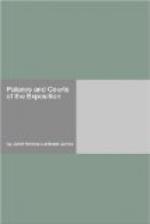The portal is the color of cork, illuminated here and there with niche walls of pink, and touches of ultramarine blue.
The fine figure work representing the modern industrial types is by Ralph Stackpole of Oregon, whose home is now in San Francisco. He expresses himself most simply and unaffectedly, in clear, broad treatment, and makes the ordinary workman a man to be honored and respected.
The upper figures represent an old man handing his burden to a younger man. The Old World Handing Its Burden to the Younger World, that is America, is finely suggested.
The keystone figure represents The Power of Industry, the man who both thinks and uses his hands.
In the tympanum are the types representing the Varied Industries.
In the center is Agriculture representing the food side of life. On the left a workman, possibly an architect, suggests the refinements of the varied industries, while on the right one sees the ordinary workman with his sledge-hammer, bringing to mind the rougher side of industry. In the left corner a woman with her spindle — a lamb standing near — recalls the making of textiles. Commerce occupies the right corner, holding the prow of a vessel with its figurehead.
The Workman with his pick is repeated in the four niches.
The two flanking portals are also in the plateresque style with devices of this Spanish Renaissance period represented on them.
The shields, or cartouches as they are called, have no special meaning, being only ornaments of this particular period.
The portals on the east of the Palace of Varied Industries and also of the Palace of Mines are suggestive of gateways of old Roman walled cities, like those of Perugia, for instance. This Italian type of portal is chosen since Machinery Palace opposite is in the Italian style of architecture.
Notice how the pastel pink accents the portal.
The figure of “The Miner” in the niches is by Albert Weinert, whose work in the Congressional Library at Washington is well known.
The Palace of Varied Industries has an exhibition of the more refined manufactures, those articles that are regarded more as luxuries, such as bronzes, jewelry, silverware, fine pottery, porcelains, rugs, leather work, silks, etc.
The Palace of Mines deals with the smelting of metals, a fine exhibition of different ores, and above all “Safety First” in its relation to mines. The Mines Rescue work is most interesting.
Flora of the Avenue of Progress and the Avenue of Palms
Eucalyptus globulus (blue gum).
Eucalyptus robusta.
Eucalyptus viminalis.
Cupressus macrocarpa (Monterey cypress).
Laurestinus.
Australian pea vine on the palms.
Muhlenbeckia (Australian mattress vine) against the
base of Machinery
Palace.
Honeysuckle against the base of the Varied Industries




